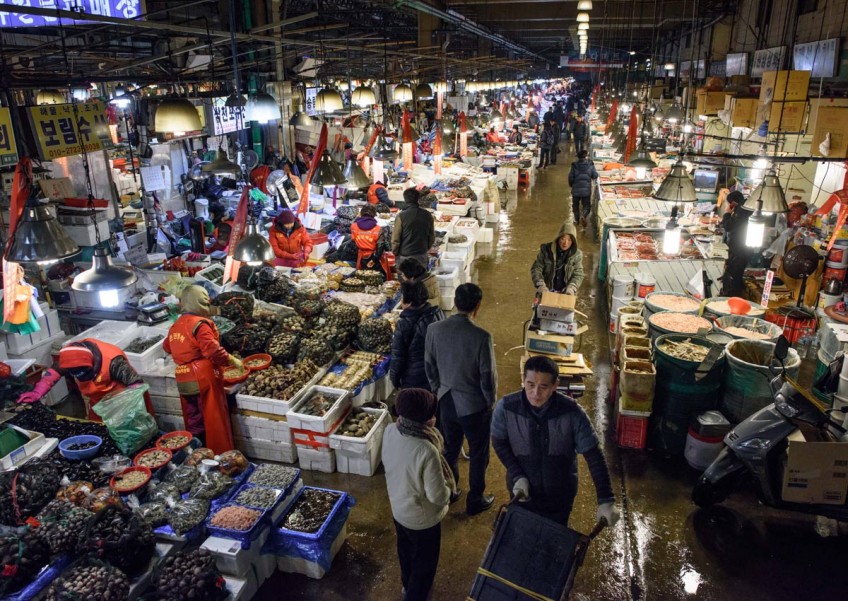Loud, chaotic, historic Korean fish market resists gentrification

Seoul - Seoul's oldest and largest fish market - a city landmark and tourist hot-spot - is fighting a move to a futuristic, half-billion-dollar facility, with vendors insisting they prefer the sprawling, run-down site they have called home for 45 years.
The dispute mirrors others in the vibrant South Korean capital, where design upgrades of some traditional locations and neighbourhoods are being fiercely resisted.
Nestled between densely packed high-rises in the southern part of the city, Noryangjin Wholesale Fisheries Market is a 24-hour sensory overload that sells pretty much every seafood imaginable - much of it still alive.
The Suhyup corporation which manages the market wants it moved into a shiny, steel and glass, state-of-the-art facility that it built next door - in the shape of a dolphin - at significant expense.
The management argues that the current site is outdated, inefficient and structurally dangerous, while the vendors say the stalls they are being offered in the new building are too small and over-priced.
Moving would "completely scrap the Noryangjin brand," said Lee Seung-Ki, who represents a vendors' committee pushing for the refurbishment of the current site.
Noryangjin snoozes but never sleeps, with some sort of wholesale or retail activity going on round the clock.
In the main retail section, banks of fish tanks, swarming with sea bream, halibut, skate, giant crab and octopus, form water-slicked corridors that stretch into the far distance.
Vendors dressed in blood-stained aprons and rubber boots engage in noisy and constant competition for customers who range from home shoppers to high-end city restaurants.
"Noryangjin is my life," said 73-year-old Baek Kyung-Boo, who has been selling shellfish in the market with his wife ever since it opened in its current location in 1971.
Baek's average day starts around 3:30am when he attends the fiercely competitive wholesale auction to pick up his daily stock.
"I spend up to 15 hours a day here," he said, as a motorbike zipped by carrying a precarious stack of boxes full of fish.
The 66,000 square-meter market has been operating 24/7 since South Korea lifted a nighttime curfew in 1982, and serves 30,000 customers a day.
It has become a cultural landmark that attracts hundreds of tourists - many to sample a local delicacy of still wriggling octopus, cut up live and slathered in sesame oil.
Vendors opposed to the move fear the market will lose its identity and the sights, sounds, smells and general chaos that make it both authentic and unique.
But the management is insistent.
"The current building is over 40 years old. Many parts of it are corroding and it's dangerous for both the vendors and customers," said Suhyup official Kim Duck-Ho.
The new complex could hardly be more different.
Along with the fish market, it will house glitzy restaurants with a spectacular river view and terrace cafes that will stage live concerts.
It has been ready to welcome new tenants since October but, four months in, it's still a ghost structure, with only the parking lot and underground refrigeration system in use.
Suhyup drafted the relocation plan in the early 2000s and insists it had settled all issues - including rents and stall space - over 23 rounds of negotiations.
But the vendors' committee and others are still refusing to shift.
"It's modern and clean for sure, but the stalls are just too small," complained Yoo Seung-Hee, who has been seeling fish at Noryangjin for 35 years.
"I nearly fainted when they finally revealed the new market. It wasn't even half the size of our current space," said another vendor, Song Yong-Shik.
The dispute has come to a head, with the management organising what they insist is a final draw for the 681 stalls in the new building.
"We are encouraging the vendors to take part in the draw. If they don't, we will understand it as a contract termination and recruit new tenants," warned Kim.
The management says it can't afford to wait any longer, given the expense of operating two buildings, and plans to complete the relocation by March 15.
"Be advised this is the last draw for space in the new building," a female voice over the tannoy system reminds vendors every few minutes.
But the opposition is not backing down, with protests being staged in the market twice a week, when vendors don red vests with the slogan "Fight in solidarity," and march through the stalls.
"Once we move, it will be our home for another 100 years. Noryangjin cannot lose its colour," said Baek Kyung-Boo.